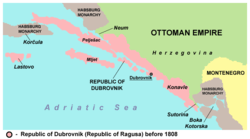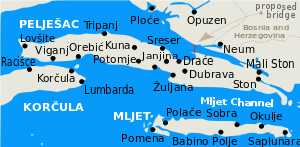Pelješac
Coordinates: 42°55′N 17°28′E / 42.91°N 17.46°E
Pelješac (Croatian pronunciation: [pɛ̌ʎɛʃats]) (local Chakavian dialect: Pelišac; Italian: Sabbioncello) is a peninsula in southern Dalmatia[1] in Croatia. The peninsula is part of the Dubrovnik-Neretva County and is the second largest peninsula in Croatia. From the isthmus that begins at Ston, to the top of Cape Lovišta, it is 65 km or 40 mi long.
Etymology
The name Pelješac is most likely derived from the name of a hill above town of Orebić, which is Pelisac. This is a relatively new name for the peninsula. Throughout history other names have been used such as Stonski Rat, Puncta Stagni, Ponta di Stagno and Sabbioncello.
Geography
The Bay of Mali Ston separates the peninsula from the Klek peninsula of Bosnia and Herzegovina and from the Croatian "mainland". The Strait of Pelješac is located at its far western end, and it divides the peninsula from the island of Korčula. On the west part of Peninsula is the highest summit of Pelješac, 961 m or 3,153 ft.
Municipalities
Administratively the peninsula is divided into the municipalities of:
- Orebić in the western part, with 4,165 inhabitants (2001)
- Trpanj in the northwest, with 871 people
- Janjina in the center, 593 people
- Ston in the east, with 2,605 residents [2]
History
The earliest known historic records of Peljesac are from ancient Greece. The area became part of the Roman province of Dalmatia after the Illyrian Wars (220 BC to 219 BC.).[3] Roman migration soon followed. In the 6th century Peljesac came under Byzantine rule.
The Great Migrations of the 6th and 7th centuries, brought the Slavic [4] invasions and Avar into this region. As the barbarians began settling on the coast, the Romanised local coastal population had to take refuge on the islands. Along the Dalmatian coast the Slavic peoples migrations poured in from the interior and seized control of the area where the Neretva River enters the Adriatic, to the Bay of Kotor. The Slavs settled on the peninsula.
The eastern part of the peninsula was part of a medieval Slavic duchy of Hum or Zachlumia, the control over which changed hands numerous times before 1333 when as a result of a war, the Republic of Ragusa bought the entire peninsula from the Serbian Empire of Tsar Dušan.[5]

The Walls of Ston are large fortifications built by the Republic of Ragusa (Dubrovnik).[6] They are the second longest walls in Europe. Ston also has one of the oldest salt planes in this part of the world.
The French Empire occupied the region in 1806, abolishing the old Republic, and in 1808 turned it into the Illyrian Provinces. In 1815 it was given to the Austrian Empire and since 1867 became part of the Cisleithania of the Dual Monarchy of Austria-Hungary. Between 1918 and 1991 it was a part of Yugoslavia.
Bridge

An additional connection between Pelješac and the mainland is planned to be created through the proposal of the Pelješac Bridge. Once completed, this bridge would physically connect all of Croatia, which is now interrupted by the strip of land belonging to Bosnia and Herzegovina at Neum municipality. The land mass that cuts Dalmatia, Croatia in two, in order granting Bosnia and Herzegovina sea access. The start of construction has been continuously delayed until shipping rights and boundaries can be properly defined between the two countries.
See also
- Geography of Croatia
- Dalmatia
- Dubrovnik-Neretva county
- Republic of Ragusa
References
- ↑ John Everett-Heath. "Dalmatia." Concise Dictionary of World Place-Names. Oxford University Press. 2005. Encyclopedia.com
- ↑ "Stanovništvo prema narodnosti, po gradovima/općinama, Dubrovačko-neretvanska županija". Croatian Census 2001/Popis stanovništva 2001. (in Croatian). Croatian Bureau of Statistics.
- ↑ Wilkes, J. J. The Illyrians, 1992, p. 120, ISBN 0-631-19807-5,Page 160
- ↑ A History of the Croatian by Francis Ralph Preveden,1955
- ↑ The Late Medieval Balkans: A Critical Survey from the Late Twelfth Century By John Van Antwerp Fine/page 286
- ↑ Ston-www.croatia1.com
External links
| Wikimedia Commons has media related to Pelješac. |